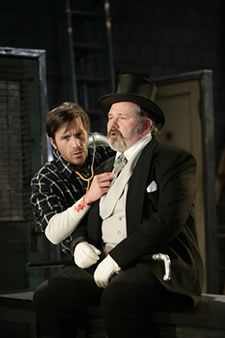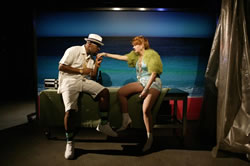
New Rags, New Bones
By Gordon Carver
Rag and Bones
By Noah Haidle
Long Wharf Theatre
222 Sargent Dr.
New Haven, CT
Box office: (203) 787-4282
Yeats was searching for a theme. During
his search he wrote a poem about the impossibility of finding
a new theme, of ever moving beyond the boundaries of his own heart.
The poem is called "The Circus Animal's Desertion" (1939). Noah
Haidle, the twenty-six-year-old playwright whose third play recently
opened at Longwharf Theater's studio stage, was also searching
for a theme. During his search he encountered Yeats's poem and
wrote a play about the possibilities of moving hearts into different
boundaries, into the bodies of diversely discontented people searching
to feel something different. The result is Rag and Bone,
a curious G 'n T aperitif that goes down smooth but leaves one
with a puzzling quinine aftertaste.
The poem's final stanza, which contains
the play's title, is prominently placed in the program and around
the theatre lobby.
A mound of refuse or the sweepings of
a street,
Old kettles, old bottles, and a broken can,
Old iron, old bones, old rags, that raving slut
Who keeps the till. Now that my ladder's gone
I must lie down where all the ladders start
In the foul rag and bone shop of the heart.
Haidle has taken Yeats's metaphors of ladder
and heart, as well as the figures of the searching Poet and raving
slut, and transformed them into literal building materials for
a theatrical environment.
Set designer G.W. Mercier has created a
Ladder Shop belonging to a pair of brothers named George and Jeff.
The perimeter of the shallow stage is littered with ladders (mostly
metallic, tall) that merge with the drab, mostly empty floor (gray,
formica) to present a banal, unadorned work area. In the center
stands a steel operating table on runners, with a credit card
swiper and kidney dish beneath. There are thick plastic curtains
and stand-alone door frames, in garish, harsh pre-set lighting.
This deadening, sanitized, distinctly modern rag and bone shop
is far from the exotically ancient and rusty locale of Yeats.
Haidle evidently questions whether poetry of any sort can flourish
in a modern environment.
We are immediately dropped into a new world
of cartoon logic when Jeff, the "slow," gentle and whimsical younger
brother (played with an appropriately needy whine and ignorant
innocence by Ian Brennan) asks George, "Do you think you could
make a ladder that goes all the way to the moon?" George, unfailingly
pragmatic, tries to explain the practical objections to such a
scheme: "the ozone layer, the earth's rotation, insurance." Jeff,
undaunted, asks, "How about a ladder to heaven? That's where Mom
is. She said she'd wait for me." "Mom's dead in the ground, Jeff.
She's not waiting for you anywhere," is George's cruel reply.
George and Jeff's opposed attitudes are
elevated into conflicting metaphysical poles that the playwright
uses to organize events. A loose theatrical argument is played
out between logic, irony, and pragmatic cynicism on the one hand
and innocence, faith, sincerity and poetry on the other. The playwright
has much fun arranging this collage of composite clichés, deployed
with sufficient moxie that they sometimes metamorphose back into
metaphors with some power.
All the play's characters, apart from Jeff,
George and T-Bone the Pimp, are nameless archetypes, referred
to as The Poet, The Hooker, The Millionaire, The Customer and
The Waiter. Stock melodramatic situations serve as an interwoven
plot and sub-plot: the estranged brothers seek reconciliation
after their mother's death, and a pimp and prostitute break up
after a violent, co-dependent relationship. The gritty realism
in these situations is overwhelmed by Haidle's wry humour and
laconic language, as well as the surreal possibilities he lays
into the conventions of his world.
Just as we begin to identify with George
as a representative of normalcy, for instance, he pulls out a
Ziploc baggie containing a large, bloody human heart. This is
the first of Haidle's several calmly surreal flips, seized upon
with relish by director Tina Landau. "These are what I sell to
make extra money. Remember?" he tells Jeff. "After I sell this
widget I'm going to live in Bermuda and you can have the ladder
store." One brother wants to make a ladder to heaven; the other
secretly performs black-market heart transplants for customers
dissatisfied with their own hearts and willing to pay for an upgrade.
 The
bridge between plot and sub-plot is the Poet's actual heart, stolen
by George and sold to the Millionaire. The Poet and The Millionaire
are thus another paired iteration of opposing metaphysical tendencies.
The Poet, as he explains to the Hooker, is now sans heart.
Consequently, he's unable to feel anything anymore and can no
longer compose poetry. The Millionaire reports to George that
his own heart is numb: "I can buy anything in the world but I
can't feel anything." George responds by selling him the "Rolls
Royce" of all hearts, the Poet's. Whoever has this heart, it is
explained, "sees the world with a profound clarity," has "a sense
of empathy that borders on the clairvoyant" and even "feels other
people's suffering."
The
bridge between plot and sub-plot is the Poet's actual heart, stolen
by George and sold to the Millionaire. The Poet and The Millionaire
are thus another paired iteration of opposing metaphysical tendencies.
The Poet, as he explains to the Hooker, is now sans heart.
Consequently, he's unable to feel anything anymore and can no
longer compose poetry. The Millionaire reports to George that
his own heart is numb: "I can buy anything in the world but I
can't feel anything." George responds by selling him the "Rolls
Royce" of all hearts, the Poet's. Whoever has this heart, it is
explained, "sees the world with a profound clarity," has "a sense
of empathy that borders on the clairvoyant" and even "feels other
people's suffering."
Because of the Hooker's sympathy for the
heartless Poet (who can now only feel physical sensations such
as sexual pleasure and bodily pain), T-bone kidnaps The Millionaire
to retrieve the heart. After disburdening the enraptured Millionaire
of his ten-million-dollar fortune, T-Bone promptly takes The Hooker
to enjoy their new wealth in Bermuda, where she abandons him and
returns with The Waiter as her new pimp. Money and Heart are thus
figures for numbness and perception. But they are also objects
recycled like Yeats's refuse of old bottles, bones and rags within
Haidle's simple yet effective pattern.
Using these motifs in such a faux-naïve
manner allows Haidle and costume designer Candice Donnelly parodic
undercurrents. Tom Riis Farrell's first entrance as the Millionaire,
for instance, in pin-stripe trousers and morning coat, combing
his moustache with pompous impatience and world-weary superiority,
recalls Georg Kaiser's Billionaire, except for the cell phone
into which he snaps commands. When possessed of the Poet's heart,
he wears a shabby, blood-stained shirt and torn trousers in which
he gasps and simpers about the world's beauty, but these clothes
repel him immediately when he reverts back to his affluent self.
The moustache groomer and cell phone instantly come out again:
"Midlife crisis bullshit. Why couldn't I buy a yacht like everyone
else."
Blood, which Landau liberally slops over
the characters, is a key visual component of this world. The Poet,
The Customer, then The Millionaire emerge post-operatively with
gore smeared over their chests, as if marked with placental fluid
denoting their rebirth into something tactile, vivid and somehow
more real than their previous, myopically clean selves. The blood
also complements the script's tendency to undercut its surface
patina of fantasy with moments of disturbing violence. T-Bone's
stylized punches are accompanied by tinny, amplified sound cues.
Both T-Bone and The Waiter wallop the Hooker in the stomach while
exclaiming, "Baby, you know I don't like hurting you. But sometimes
you give me no choice. Every time it breaks my heart." Blood is
also a reminder of the generational ties that link the brothers
to their mother and T-Bone to his Momma, who died giving birth
to him. Woven into the brutal stories is a delicate sketch about
generational sacrifice.
The most satisfying element in the production
is Landau's rough, minimalist handling of the triumph of the poetic
spirit. An especially graceful and poignant moment is when T-Bone
"walks into the surf." Landau places a backlit scrim high upstage
with a fluorescent azure sea and mauve sand. T-Bone, singing,
turns round and walks slowly upstage to meet the scrim, now moving
towards him, and actor and scrim revolve in a synchronized dance,
with the scrim enveloping him in its lonely, welcoming waves.
Rag and Bone is sometimes arch
and too calculatingly naïve. It nevertheless whets my appetite
for more from this playwright--a main course to follow the aperitif.
The play is a fantasy of literalness, of being literal-minded
to the point of fantasy, where one might imagine actually making
a ladder up to heaven. The script constantly negotiates the tension
between the literal, material objects of life and their metaphoric
(poetic) import. Come to think of it, that's what theatre always
does and, on a good day, does better than any other medium.
